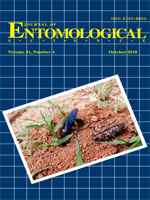Western flower thrips, Frankliniella occidentalis (Pergande), is an economically important pest of greenhouse production systems, and entomopathogenic fungi may be used to suppress populations of the western flower thrips. The objectives of our study were (a) to evaluate the efficacy of products containing three different entomopathogenic fungi (Beauveria bassiana [BotaniGard®], Isaria fumosoroseus [NoFly™], and Metarhizium anisopliae [Met52®]) against western flower thrips larvae and adults and (b) to assess effectiveness of combinations of entomopathogenic fungi and the insect growth regulator azadirachtin against western flower thrips larvae. In two laboratory bioassays western flower thrips larvae and adults were exposed to the three entomopathogenic fungi at two label rates (maximum and minimum), and two product shelf-life conditions (unexpired and expired). Bioassay 1 involved a 120-h incubation period; bioassay 2 entailed a 216-h incubation period. A third bioassay evaluated any synergistic effects of combining the entomopathogenic fungi with azadirachtin on western flower thrips larvae. Results indicated that (a) by 120 h of incubation, adult western flower thrips were more susceptible than larvae to maximum rates of unexpired B. bassiana and I. fumosoroseus; (b) unexpired products of B. bassiana and I. fumosoroseus had higher percentages of adult western flower thrips mortality than expired products at the maximum label rate; and (c) azadirachtin combined with unexpired M. anisopliae at the maximum label rate resulted in greater mortality of western flower thrips larvae than B. bassiana and I. fumosoroseus. However, there was no evidence of any enhanced efficacy when combining azadirachtin with B. bassiana or I. fumosoroseus.
BioOne.org will be down briefly for maintenance on 17 December 2024 between 18:00-22:00 Pacific Time US. We apologize for any inconvenience.
How to translate text using browser tools
1 October 2016
Evaluation of Entomopathogenic Fungi Against the Western Flower Thrips (Thysanoptera: Thripidae) Under Laboratory Conditions
J.M. Kivett,
R.A. Cloyd,
N.M. Bello
ACCESS THE FULL ARTICLE
azadirachtin
Beauveria bassiana
Isaria fumosoroseus
laboratory bioassay
Metarhizium anisopliae





